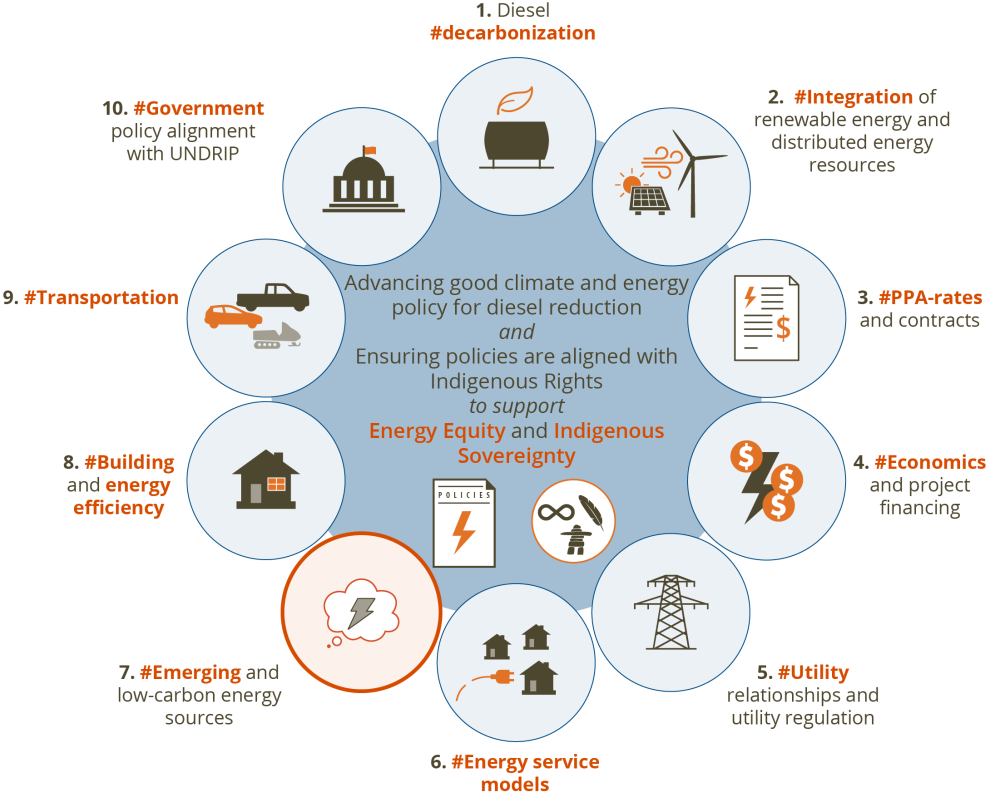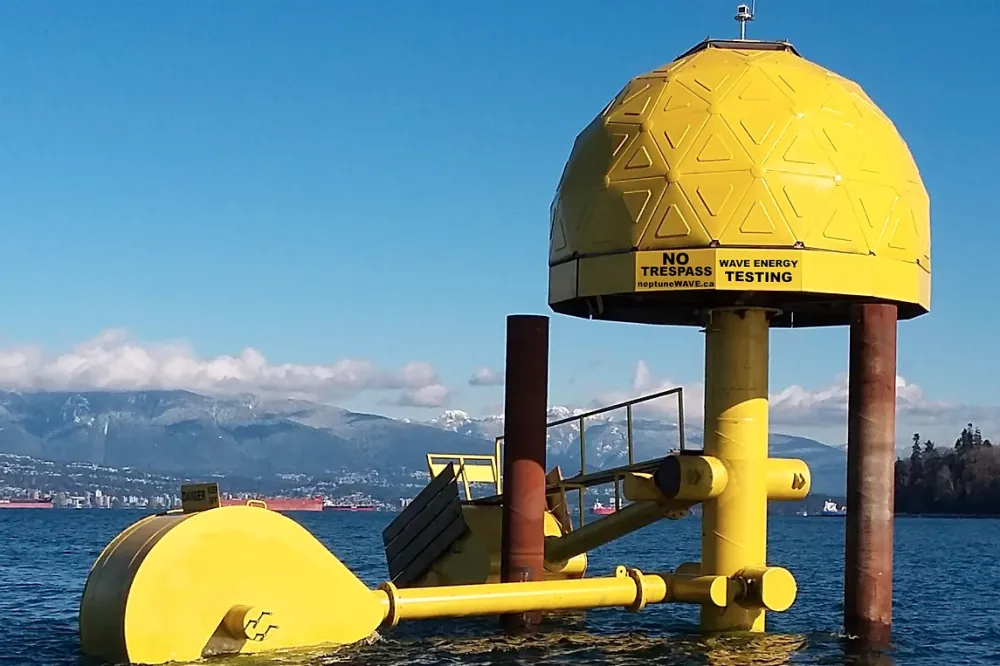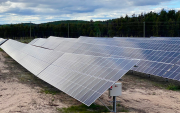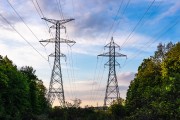This is the eighth publication in Climate and energy policy advancements: Eliminating diesel in Canada’s remote communities, a series providing insights, details, and analysis of each of the specific policies we advocate for under our Renewables in Remote Communities (RiRC) program and the Indigenous Off-diesel Initiative (IODI).
In remote communities across Canada, low-carbon power sources such as hydrogen, nuclear, and energy generated by movement in the ocean are being studied more closely. Each of these clean energy technologies are options under consideration as remote Indigenous communities further their efforts to eliminate dependence on diesel power.
Clearly there are environmental and health benefits to transitioning away from a carbon-intensive energy source. In addition, clean energy presents economic and business opportunities. However, these benefits will only materialize if Indigenous communities have control over which technological options should be assessed on their lands and the opportunity to explore partnerships that will deliver these solutions in time to meet climate targets. Indigenous communities have reason to be cautiously optimistic about the possibilities that low-carbon technologies offer and the potential to take a leadership position in energy development.
The Government of Canada has pledged that remote communities will have transitioned off diesel by 2030 and that Canada’s electricity system will produce net-zero carbon emissions by 2035. To achieve these goals, energy systems will need to be decarbonized more quickly than at the current pace. Most of the renewable energy projects in remote communities have been small hydro, biomass heating, solar photovoltaic, wind turbines, and energy efficiency projects, which contribute to reduced dependency on diesel.
As the cost of renewable energy declines, uptake of renewables has increased. The growth in clean energy can also be attributed to accumulated experience and knowledge sharing, and supportive government policies and programs. Now emerging low-carbon technologies have the potential to contribute to Canada’s climate and energy targets and remote communities’ efforts to decarbonize their electricity, heating and transportation systems. Below we consider three emerging clean energy technologies that are receiving the bulk of the attention: hydrogen, nuclear small modular reactors, and ocean energy.
Hydrogen
Using hydrogen as an energy source can contribute to the transition of Canada’s energy systems, particularly in hard to decarbonize sectors such as heavy-duty transportation. The federal government set an ambitious target with its announcement that hydrogen power will make up as much as 30% of Canada’s end-use-energy by 2050. This target will likely incentivize the production and integration of hydrogen into the energy grid. Although hydrogen isn’t currently used in remote Indigenous communities, it has advantages that could benefit these areas. For instance, hydrogen can be used for heating, generating electricity and to power vehicles. As remote communities develop intermittent renewables such as wind and solar power, solutions will be needed for long-term, large-scale energy storage.
Renewable energy can be used to produce low carbon hydrogen (green hydrogen). Hydrogen can also be produced by converting natural gas into hydrogen and capturing the carbon dioxide created in the process and storing it underground (blue hydrogen).
Hydrogen that is produced from natural gas without carbon capture is not low carbon hydrogen and is referred to as "grey hydrogen.” While hydrogen does not produce carbon emissions at the point of use when combusted, nitrogen oxides are emitted, which may lead to health concerns.

Today, green hydrogen is more expensive than blue hydrogen although the cost of green hydrogen is anticipated to come down. Other challenges to building hydrogen projects include investors’ perceptions of associated risk, lack of demand for hydrogen, and the need for policies to encourage adoption.
Small modular reactors
The Government of Canada defines small modular reactors (SMRs) as “a source of clean, safe and affordable energy” and are regarded as a viable technology to replace expensive, aging, and polluting diesel energy systems in remote Indigenous communities. SMRs are nuclear reactors that produce between a few megawatts (MW) to 300 MW of electricity, making them substantially smaller than traditional nuclear power plants (on average 800 MW) but much larger than a remote community’s total energy capacity (on average 2.2 MW). SMRs produce zero greenhouse gas emissions during operation and can be a power source for the production of heat. SMRs also require less fuel and re-fueling than diesel generators.
Issues have been raised concerning SMRs in remote communities such as lengthy deployment timelines, high associated costs, and public liability associated with radioactive waste management.
Costs and timelines vary depending on the design of the SMR. Planning is underway in Saskatchewan, New Brunswick, and Ontario to build SMRs that will be connected to the grid with the first SMR providing power by 2028. Because of the variability among SMR design requirements, it is unclear whether SMRs will be able to generate electricity at a more affordable rate than diesel or other currently available or emerging clean energy technologies. Consequently, the role that SMRs can play to advance a transition off diesel in remote communities by 2030 is far from certain.
Among Indigenous Peoples, viewpoints also vary. Anishinaabe Chiefs in Ontario have denounced SMRs and have endorsed a Grand Council Resolution opposing SMRs in their territory and bodies of water. However, seven Indigenous groups have signed onto Canada’s SMR Action Plan and three First Nations companies in Saskatchewan have signed an MOU to show their support for nuclear power in their province.
Energy generated by ocean movement
Ocean water movement has immense potential energy that can be utilized by remote, coastal communities. A recent study shows that tidal stream turbines — which are similar to wind turbines and can be planted on the sea floor using the motion of the water rather than the wind to move the blades — could offset diesel consumption in remote First Nations in British Columbia, specifically in nine communities in North Vancouver Island, the North Coast, and the Haida Gwaii regions. First Nations on Vancouver Island, T’Sou-ke Nation and Mowachaht/Muchalaht First Nations, have already started to develop wave energy projects.
One of the benefits of ocean energy is that it is a predictable renewable energy source (unlike solar and wind which are intermittent), making it advantageous for grid integration. The main barriers to marine renewable energy, similar to other emerging energy sources, are the unknown costs, less developed supply chain, and unfamiliarity with the operation and maintenance of the technology.
Next steps
With dedicated resources, emerging low-carbon technologies can play a role in the energy transition in remote communities. The main challenge with commercializing any new technology is market readiness. All levels of government need to commit to dedicated funding streams for Indigenous communities to conduct feasibility studies and community engagement for a particular source of clean energy in their community. It is also critical to address the associated high costs of newer low-carbon technologies to attract and de-risk investment. With the right policies, financing and political will, the 2030 climate goal for remote communities can be achieved and Indigenous Peoples can realize energy sovereignty and sustainability in their territories and lands.

Climate and energy policy advancements: Eliminating diesel in Canada’s remote communities
Publications in this series:
- Rethinking energy policy in Canada’s remote communities
- How to boost renewable energy integration in remote communities
- What’s a fair and equitable price for renewable energy in remote communities?
- Better government policies will unlock the cash remote Indigenous communities need for clean energy
- Reducing emissions from diesel generators in remote communities
- When business-as-usual is a barrier to clean energy
- From diesel dependency to energy empowerment
- Three clean energy options that could help replace diesel
- Remote communities transitioning to clean energy need better housing
- How remote communities should be included in the push to electrify transportation
- Government action on UNDRIP and the clean energy transition









